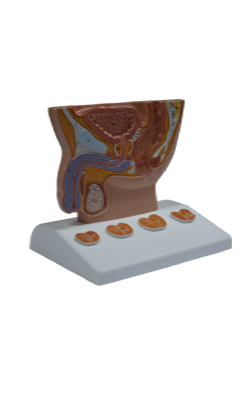Main Model

Cavernous body of penis

The penis is the male copulatory organ and, by conveying the urethra, provides the common outlet for urine and semen. The penis consists of a root, body, and glans. It is composed of three cylindrical cavernous bodies of erectile tissue: the paired corpora cavernosa dorsally and the single corpus spongiosum ventrally. In the anatomical position, the penis is erect; when the penis is flaccid, its dorsum is directed anteriorly. Each cavernous body has an outer fibrous covering or capsule, the tunica albuginea. Superficial to the outer covering is the deep fascia of the penis (Buck fascia), the continuation of the deep perineal fascia that forms a strong membranous covering for the corpora cavernosa and corpus spongiosum, binding them together. The corpus spongiosum contains the spongy urethra. The corpora cavernosa are fused with each other in the median plane, except posteriorly where they separate to form the crura of the penis. Internally, the cavernous tissue of the corpora is separated (usually incompletely) by the septum penis.